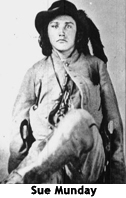|
Thanks to Louisville editor, Sue Munday
became feared named among guerillas
By BRYAN BUSH
Bugle Staff Writer
George Prentice, editor of The Louisville Daily Journal, is most often credited with the “invention” of Sue Munday.
 Munday actually was Jerome Marcellus Clarke, former scout and artillerist for Confederate Gen. John Hunt Morgan, who joined a guerilla band after Morgan’s death in 1864. Munday actually was Jerome Marcellus Clarke, former scout and artillerist for Confederate Gen. John Hunt Morgan, who joined a guerilla band after Morgan’s death in 1864.
The origin of Clarke’s nom de guerre is shrouded in mystery, but may have stemmed from his shoulder length hair and feminine characteristics, which led newspapers and witnesses to think he was a woman. His exploits were written about by Prentice, who called him Sue Mundy, a name supposedly borrowed from a Suzanna Monday, a free black woman in Nelson County known for her cruel nature.
Since Prentice could not outwardly criticize the Union military authorities, he used the character Sue Munday to vent his frustrations at the Union military commanders.
Although Clarke did commit shootings, train robberies as well as the burning of bridges and at least one courthouse, Prentice blamed him for many crimes that he did not commit.
After Morgan’s death, Clarke returned to Kentucky where he joined Sam “One Arm” Berry, Henry Magruder, and others in a guerilla band that terrorized the state from mid-1864 until the end of the War.
On some occurrences, Clarke was reportedly present at two different places at the same time. Early in 1865, Clarke and his men joined Missouri guerilla leader William “Bloody” Quantrill during his raid in central Kentucky.
On March 12, 1865, 50 Union soldiers from the 30th Wisconsin Infantry, under the command of Major Cyrus B. Wilson, surrounded Clarke and his men, near Breckinridge County. Gunfire broke out and Clarke, along with his command, was captured. A military tribunal in Louisville found Clarke guilty of guerilla activities.
On March 15, 1865, he was hanged at the old fairgrounds on Broadway, near 18th Street before a crowd of thousands of people and his body was returned to Simpson County for burial.
On Aug. 25, 1844 (or possibly 1845), near Simpson, Ky., Brig. Gen. Hector M. and Mary (Hail) Clarke welcomed into the world their son Jerome Marcellus Clarke. Both parents died before Jerome was 10 years old and he was raised by relatives and received a common school education.
On July 4, 1861, Jerome enlisted in the Confederate army and on Aug. 25, 1861, he joined the Fourth Kentucky Infantry, Company B, First Brigade at Camp Burnett near Clarkesville, Tenn. In February 1862, he was taken prisoner when Fort Donelson in Tennessee fell to Union Gen. Ulysses S. Grant’s army. He was sent to Camp Morton near Indianapolis. He managed to escape prison and fled to Newburgh, Ind., where Clarke, along with several other members who escaped the prison, devised a plan to take the Union garrison stationed in the town.
The garrison surrendered and Clarke returned to Kentucky and joined Morgan’s cavalry command and fought during many of Morgan’s campaigns.
(EDITOR’S NOTE: Bryan Bush is a well-known Civil War author and magazine writer from Louisville. He has served as a consultant about the War-Between-the-States for a variety of preservation societies and historical sites, other authors, museums and motion picture companies. More about Bush appears in a story elsewhere in this issue.)
|







